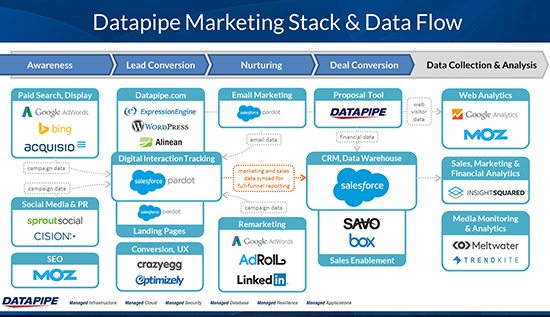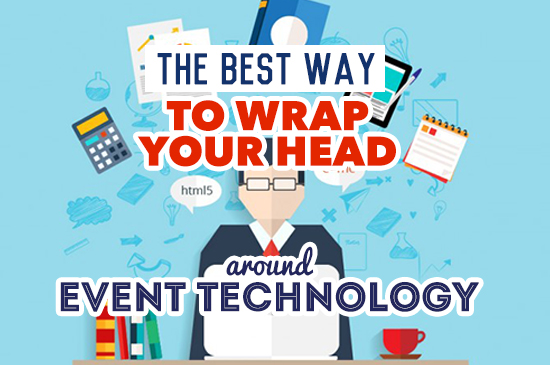Chiefmartec.com’s inaugural “Stackies” awards help to explain technology stacks. The competition invited marketers to submit a “single-slide diagram” of all the different marketing software products used in their work. Entries revealed a variety of approaches for visualizing the technologies: by marketing function, buyer’s journey, systems architecture, and data flow.
Recently, some thought leaders in the event industry have begun talking about event-technology stacks to describe how the wide variety of platforms and apps for events might be organized and analyzed more holistically. The stack approach provides event organizers with some compelling abilities and opportunities.

How Event Technology Stacks Help
By creating an event technology stack, event organizations can acquire some valuable capabilities:
Identify gaps and overlaps. Laying everything out on “paper,” lets managers see what types of technologies they have and what they’re missing. It allows them to observe whether existing solutions duplicate or complement event tasks and objectives.
Visualize dependencies and relationships. Stacks illuminate relationships between technologies. Some apps can’t really exist without others. Registration software, for example, is a foundational component of many event-technology stacks because without attendee and programming information, mobile apps have no purpose.
Leverage data across the stack. Looking at event technology as a stack provides organizations with a bird’s eye view of all the sources of data that exist in and around the event.
Map data flow from one app to another. An event-technology stack visualization is a blueprint for using data. Organizations can look at the stack to see where data originates, how it is enhanced, and what it becomes in the course of planning and executing the event.
Allocate resources more efficiently. Analyzing the technology stack helps event organizers see where resources are being used and where they might be required. It can help them make better decisions about investment and resource allocation.
Build unique end-to-end processes. The stack approach can help event organizations define and potentially automate processes, such as collecting leads through marketing automation then transferring them to a CRM and finally plotting sold booths on an online floor plan.
Support new technology purchases. Buyers and decision makers within the event organization can use an event-technology stack to demonstrate a gap in automation or data in order to justify a purchase.
Discover and promote synergies. By taking an inventory of the technology the organization has, it can look for ways to make the apps and platforms work better together.
Staying ahead of the technology curve. Ultimately, an event-technology stack helps companies and event manager clearly see whether they have best-of-breed solutions or cobbled-together temporary fixes.
Possible Event Technology Stack Scenarios
Event technology stacks can be organized in many different ways. Here are three different groupings that event organizations can consider:
Note: Most technology stacks identify the specific companies and/or solutions being used. This analysis will use software/device categories only.
By Department
– Marketing
– Marketing automation platform
– Website software
– SEO app
– Advertisement distribution solution
– Social media and public relations platform
– Content development and distribution app
Operations
– Event Management Platform
– Check-In App
– Registration System
– Audio-Visual Planning Tool
– Project Management Software
– eRFP tool (venues, hotels, contractors)
– Event-Mobile App
– Attendee Networking App
– Volunteer Management Tool
– Social Wall
– Room Block Management Tool
Accounting/Financials
– Forecasting/budgeting software
– Cash flow analysis tool
– General ledger, P/L, payables, receivables system
– Invoicing software
– Strategic meetings management platform
Exhibit/Sponsorship Sales
– Customer relationship management (CRM) solution
– Online floor plan app
– Lead generation software
Customer Service
– Telephone/email/messaging system
– Call center solution
Conference Program
– Speaker management platform
– Call for papers or presentations software
– Session picker app
– Attendance monitoring app
– CEU tracking system
By Event Cycle
Budget Preparation
– Accounting/financial reporting software
– Strategic meetings management platform
Venue Selection
– eRFP tool
– Contractor management platform
Exhibitor/Sponsor Sales
– Customer relationship management (CRM) solution
– Online floor plan app
– Lead generation software
Conference Program Development
– Speaker management platform
– Call for papers or presentations software
– Session picker app
Audience Promotion/Exhibitor Marketing
– Marketing automation platform
– Website software
– SEO app
– Advertisement distribution solution
– Social media and public relations platform
– Content development and distribution app
Registration
– Registration software
– Room block management platform
– Travel management solution
On-site Event Management
– Event management platform
– Check-in app
– Project management software
– Event-mobile app
– Attendee networking app
– Appointment-setting solution
– Volunteer management tool
Surveys/Data Collection
– Session evaluation tool
– Audience response systems
– Attendance tracking app
– RFID/NFC/beacons
– Event-mobile app
By Stakeholder
Attendee/Delegate
– Registration system
– Check-in app
– Coat-check app
– Event-mobile app
– Appointment-setting platform
– Peer-to-Peer networking software
– Social wall
– Gamification platform
– CEU tracking system
– RFID/NFC/beacons
Exhibitor/Sponsor
– Website software
– CRM solution
– Marketing automation platform
– Lead generation software
– Online floor plan/booth allocation platform
– Proposal software
Contractor/Hotel/Venue
– eRFP tool
– Room block management software
– Contractor management platform
Speaker
– Speaker management platform
– Abstract management software
Media
– Online press room
– Marketing automation platform
– Content development and distribution app
In Conclusion
The development and visualization of event technology stacks can help event organizations select, manage, integrate, and leverage the various technologies available to them. When insight from the stacks is used appropriately, executives and decision makers can significantly improve and enhance their businesses and their events.





